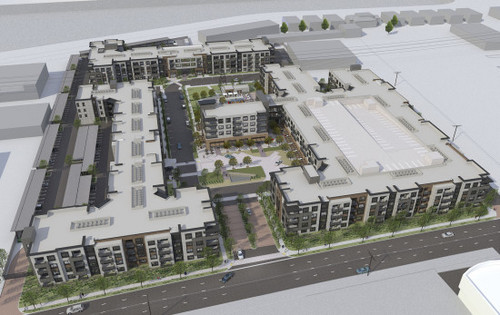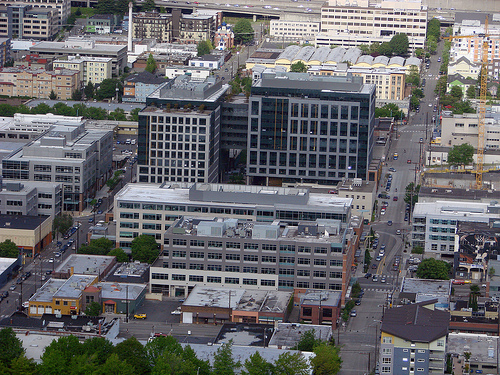GGW debates Facebook’s new apartment complex
Facebook will help finance an apartment complex for employees and low-income households near its Menlo Park, California headquarters. It’s the city’s first housing development in 20 years. Will Anton Menlo be a 21st-century “company town,” or could it ease Silicon Valley’s transportation and housing issues?
In a new feature, we asked five contributors to offer their thoughts.
Neil Flanagan: Facebook’s sponsorship is really the only unusual feature of this project. Developers are already large corporations who must look for investors that believe the profitability of a project. The kind of directness Facebook brings does cast a specter of trying to insulate and isolate the residents. Given that there’s not much street life around it, isolation might be unavoidable. If the street urbanizes further, this might get more complicated.
Here, as is common when large suburban properties become residential complexes, developers often fill out street networks that remain private. Perhaps what we should worry about is how much of this new urban vitality remains exclusive. Bringing it closer to home, the private courtyard at CityCenter DC looks really promising as an urban space. How will it shape up as a public space? Will the whole city feel welcome there?
Facebook’s current and future headquarters buildings in relation to the Anton Menlo.
Canaan Merchant: I first heard about the new Facebook apartments from ValleyWag, which said the project includes “all the comforts of suburbia” and proceeded to tear down particular aspects on the project including the fact that it is compact and walkable. It’s reflective of an attitude that I often see expressed in a lot of thinking about our built areas, that usually boils down to the argument that the suburbs are “fake” and the city is “real.”
Instead of worrying about authenticity, I would prefer that we would worry about the factors we can control. Is it walkable? Are the public spaces inviting and successful? Is there diversity in the design? Would I feel comfortable biking in the street? I think those are the important things to consider, rather than the name or company behind the construction.
Payton Chung: I applaud any attempt to build infill multifamily in Silicon Valley, and corporate leadership as part of a broader effort to reshape the Valley, but few individual employers can hope to constructively engage such a vast problem.
Upon first glance, Anton Menlo’s site plan doesn’t looks too surprising: a typical “Texas donut,” similar to other wood-frame apartments you see around, say, the Vienna Metro station. Half of the roadways will read as streets, with sidewalks and parallel parking, and the much-ballyhooed amenities aren’t atypical for new apartments these days.
Media ruckus aside, Facebook isn’t diversifying into town-building, and understandably so, since such corporate experiments in non-core businesses have a poor track record (perhaps aside from university towns). Instead, it’s simply supporting a suburban apartment developer with experience in the matter, but also a formulaic product.
Yet this location contributes to the Valley’s record of poorly coordinated planning: it’s marooned between warehouses, the Bay, and a freeway, a location perhaps
akin to these apartments in Alexandria’s Eisenhower Valley. Building housing close to work is a nice idea, but this particular implementation undermines, rather than facilitates, the Valley’s emergence as an urban place.
Tracey Johnstone: Company housing, such as Facebook is developing, could be helpful in creating a sense of community among its employees just as military housing does in the military. The high tech business is a volatile one, and it demands long hours from its employees.
Having neighbors who understand those demands might ease some of the high stress of working in that industry. If Facebook employees/tenants decide they don’t like living there or don’t want to be so dependent upon Facebook, their salaries make it possible for them to move elsewhere.
Amazon.com went the opposite direction of Facebook. It chose to locate its offices in a benighted corner of Seattle, adjacent its heart. It turned South Lake Union around and is now a strong anchor along the city’s streetcar and light rail stations.
David Edmondson: Investments from other large companies helped turn around downtown Detroit and downtown Las Vegas, too. Though Menlo Park is not a prime urban center like Seattle, its strong bones have been weakened by parking lots and the signs of suburbia.
Yet rather than invest near its high-capacity Caltrain station, the heart of downtown, Facebook chose to redevelop an industrial site 3 miles away, on the other side of a freeway. While housing plus offices is certainly a step forward from the office park, one hopes our cities and suburban town centers will see more Amazons, not more Facebooks.
What do you think about this project? How involved should employers be in the real estate choices of their employees? Got an idea for future GGW debates posts? Let us know in the comments.


